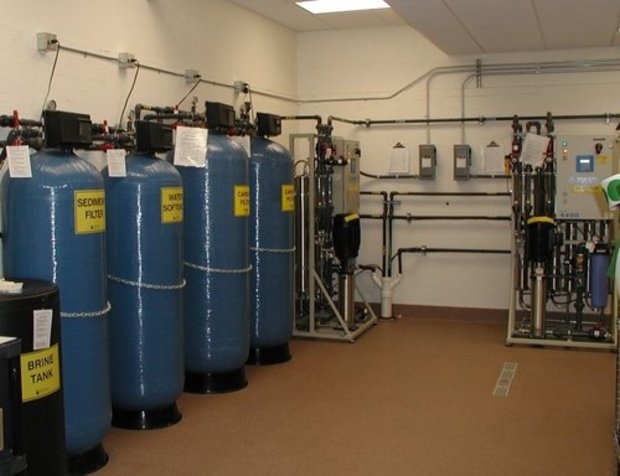Hydro water treatment also refers to using water purification technologies in hydroelectric power plants to ensure the water used in the turbines is clean and doesn’t damage the equipment. A hydro water purification system as a term can be confused for a hydro plant that purifies water exclusively, as it is often used to refer to a water treatment method that utilizes hydroelectric power to help purify and treat water.
Hydro Water Treatment
Here, hydro treatment is a part of the process to create a self-sustaining economy of treatment. The specific process can vary depending on the system and its design, but some hydro water plants and municipal treatment plants generally work similarly to each other.
Water Intake
The first step is to secure some water from a specific source. At times, the source can vary, but mostly water sources are selected, such as groundwater and freshwater sources rather than taking it directly from the ocean.
The system starts by drawing water from a natural water source, such as a river, stream, or reservoir. The water source should be relatively clean to begin with, but it may still contain impurities, sediments, and contaminants.
Screening
Depending on the source, there might be some larger impurities in the water. A preliminary screening process is used to remove larger debris like leaves, twigs, and other solid particles from the incoming water. This step helps prevent damage to the equipment downstream, which focuses more on fiber, smaller particles and impurities.
Sedimentation and Coagulation
The water is then directed to a sedimentation basin or tank where it is allowed to sit undisturbed. During this period, larger particles and impurities in the water will settle to the bottom of the tank due to gravity. These settled particles are called sediment or sludge, and they are removed from the tank periodically.
To further clarify the water, coagulants like aluminum sulfate (alum) or ferric chloride are added to the water. These chemicals cause small particles and impurities to come together and form larger clumps, a process known as coagulation. After coagulation, flocculants like polymers are added to help the particles agglomerate into even larger flocs. This can help separate the dissolved solids in the water from the solvent itself, which can later be filtered out.
Filtration
The water then passes through a series of filters, such as sand, gravel, or activated carbon filters. These filters remove suspended particles, microorganisms, and some dissolved impurities. The choice of filtration media depends on the specific requirements of the purification system.
For example, there can be carbon filters for something relatively larger in size, such as coffee beans, compared to the near-microscopic sizes of smaller particles such as dust. These can be fifty times smaller than the average coffee bean, and almost impossible to catch in a regular carbon filter often found in Brita containers or in taps.
Disinfection
After filtration, the water is disinfected to kill or inactivate any remaining harmful microorganisms, such as bacteria and viruses. Common disinfection methods include chlorination, ultraviolet (UV) irradiation, or ozonating.
It is important to know that the chlorination process, as an example, uses specific and calculated thresholds of chlorine that are harmless when consumed on a regular basis–at least in the levels they are put in the water we drink. Pool water, by contrast, contains much higher levels of concentration, and is very harmful to drink as a result.
Hydroelectric Power Generation
If it is a hydro electric power system, the entire treatment process is often powered by hydroelectric generators. Water that has been purified and treated is channeled through turbines, which are connected to generators. The kinetic energy of the flowing water turns the turbines, generating electricity that can be used to power the purification equipment and potentially export excess power to the grid.
In other water purification plants, the treated and purified water is stored and distributed to homes, businesses, or other end-users through a network of pipes.
Overall, the specific design and components of hydro water purification systems can vary significantly, depending on factors like the quality of the source water, the treatment goals, and the scale of the system.
Is Hydro Water Safe and Pure?
Hydro water can be a misnomer at times, similar to how some people refer to traditional south Asian tea as ‘chai tea,’ which basically means ‘tea tea,’ if translated. Both hydro and water mean the same thing, and it is a term used simply to describe water treatment in a hydroelectric plant.
These systems, in the context of hydroelectric power generation or water treatment, are not typically used directly in the process of most medical procedures and industrial processes, such as dialysis and manufacturing. Let’s use it as a basis for helping you understand the difference between regular treated water and the purer form of water called ultrapure water.
Dialysis and Water Treatment
Dialysis is a medical procedure used to filter and purify the blood of individuals with kidney failure or severe kidney dysfunction. Instead, dialysis relies on specialized medical equipment and processes designed to perform the functions of the kidneys, in which water has to be injected into the bloodstream.
Of course, this can be a huge risk to the patient, as treated water contains chlorine and other impurities. These are generally safe to drink, but not safe to inject inside one’s bloodstream. That is where ultrapure water treatment methods and water treatment for dialysis come in.
These water treatment systems may incorporate multiple stages, such as reverse osmosis, deionization, and microbial control, to ensure the water is of the required purity for dialysis. Therefore, while hydro water systems are not directly used in the dialysis procedure, water purification is an essential component of the infrastructure in a dialysis center to provide safe and clean water for the dialysis machines and solutions, and it uses a specific type of water, as mentioned above, that needs to be void of both beneficial and harmful impurities.
Semiconductor Manufacturing
Ultrapure water is crucial in the semiconductor industry for cleaning and rinsing silicon wafers during the manufacturing of integrated circuits and microchips. Any impurities in the water can affect the performance and reliability of the electronic components.
Pharmaceuticals, Labs, and Biotech
Ultrapure water is used in pharmaceutical manufacturing for preparing solutions, cleaning equipment, and conducting quality control tests. It is essential to ensure the purity and safety of pharmaceutical products. Laboratories that create these medicines use ultrapure water for various scientific experiments, particularly in molecular biology, analytical chemistry, and other research fields. It is also used as a solvent, reagent, and for equipment cleaning to prevent contamination.
Ultrapure water is even essential in biotechnology for processes such as DNA sequencing, protein analysis, and cell culture. Contaminants can interfere with the accuracy of experiments and the reliability of results.
Soda Manufacturing
Even the soft drinks we have with our fast foods every single day are made with ultra-pure water. It’s used in many aspects of food and beverage production, particularly in applications where water quality is critical to the final product’s quality and safety. This allows finer control of what chemicals are put in to meet safety, healthy, and regulatory standards, not to mention to keep the consistency of the recipes as well.
A Sustainable Option for Water Treatment?
Whether it is hydro water plants or ultrapure water treatment systems that make it, these are systems that are highly complex, involve multiple stages, and have been used for decades. However, limitations and potential avenues for improving them still exist, such as better monitoring for impurities, improving regulatory compliance, and generally making water treatment more efficient. Hydro treatment plants offer a potential avenue for more sustainable treatment in the future as well.





